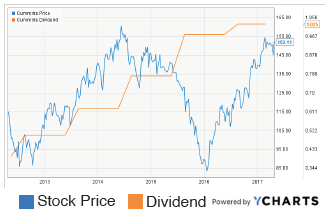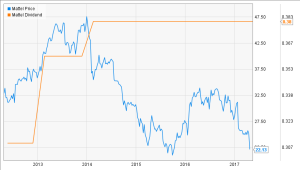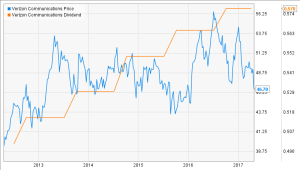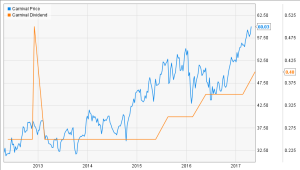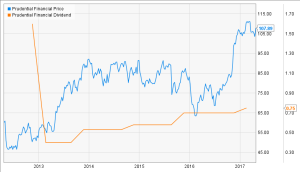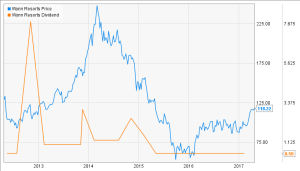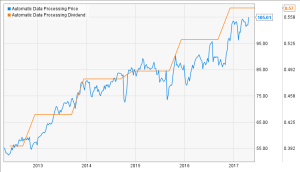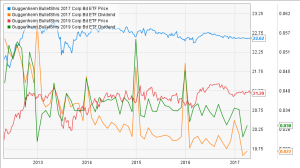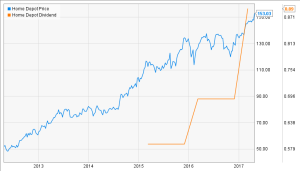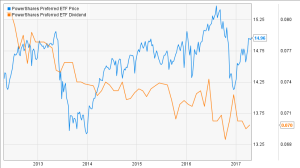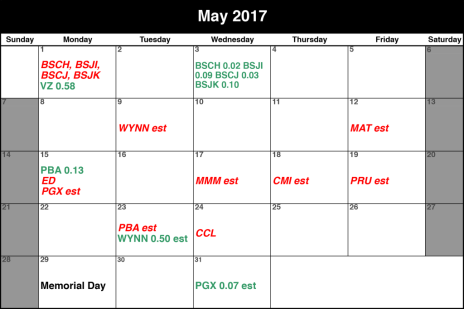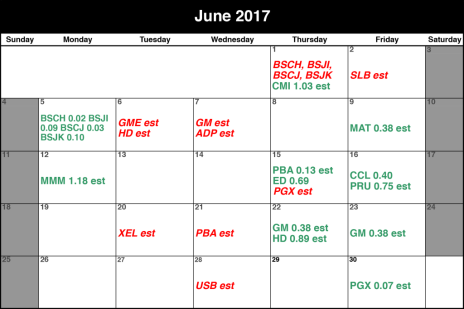In today’s issue, we add a large-cap industrial stock to the Dividend Growth Tier, review our sales from the past week, and explain how to write covered calls.
Cabot Dividend Investor 417
[premium_html_toc post_id="133384"]
Off to the Races!
The market is off to the races again. The Nasdaq closed above 6,000 for the first time ever this week, and the S&P 500 is within shouting distance of all-time highs.
The rally started last week and has gained strength over the past two days after the first round of the French Presidential election pointed to a moderate result. Strong earnings announcements from 3M, Caterpillar, DuPont, McDonalds and other large American companies fueled a second day of gains yesterday.
It’s time to be positioning yourself to take advantage of a bull market.
[highlight_box]What To Do Now: In our portfolio, that means adding positions with growth potential, while selling our laggards, including three stocks that disappointed on earnings last week: U.S. Bancorp (USB), Mattel (MAT) and Schlumberger (SLB). We’re still holding Verizon (VZ), which also missed estimates, but we’re watching it closely.
More earnings are coming up this week. We’re expecting results from General Motors (GM), Prudential (PRU), Automatic Data Processing (ADP) and Xcel Energy (XEL). All look fairly healthy except GM, whose results we’ll be watching closely. Elsewhere, GameStop (GME) is back on Buy, and Pembina (PBA), Carnival (CCL), Wynn (WYNN), 3M (MMM) and Home Depot (HD) can all be bought on pullbacks. [/highlight_box]
Featured Buy
Cummins (CMI)
The broad market is waking up from its spring slumber, so it’s time to add some growth potential to our portfolio. That led us to today’s new addition to the Dividend Growth Tier, a multi-national industrial that’s growing again after two years of struggles. In addition to earnings growth and rising estimates, Cummins (CMI) offers a very stable dividend with a 2.7% yield.
The Company
Cummins makes engines. The company’s powerful diesel and natural gas engines are used in trucks, busses, heavy-duty construction and mining vehicles, farm vehicles, military vehicles, ships, locomotives and pickup trucks. About 58% of revenue comes from the U.S. and Canada. Demand for Cummins’ products is driven by the U.S. trucking industry and global construction and industrial production (especially in China and India).
Revenues peaked in 2014, thanks to strong trucking activity in North America. But a global economic slowdown and the strengthening dollar delivered a big hit to sales in 2015, and Cummins missed estimates badly in the third and fourth quarters. Revenues and earnings both stopped growing and started declining. In 2016, international demand started to improve, but U.S. trucking slowed, and sales and earnings fell for a second year in a row.
The company shifted its focus to improving profitability, and managed to beat expectations in each quarter of 2016, despite continuing sales declines. Now, sales have leveled out, and over the past month, five analysts have increased their 2017 earnings estimates. Revenues are still expected to be about flat this year, but analysts now expect EPS to rebound about 5%. And low single-digit revenue growth is expected to return in 2018, driving 15% EPS growth. Over the next five years, earnings growth is expected to average just under 10% per year.
The first quarter of 2017 will likely be the slowest. Cummins will hold their first-quarter earnings call on Tuesday, May 2. Analysts expect revenue and net income will both fall 3%, to $4.16 billion and $1.83 per share. While that’s the opposite of growth, both estimates have increased in recent weeks.
The Dividend
Cummins aims to return about half of operating cash flow to shareholders, and continued to increase the dividend even as earnings shrank over the past couple years. That drove CMI’s payout ratio to 57% last year, quite a bit above its historical average of 23%. It’s now coming down as earnings start to rebound.
CMI still receives a very strong Dividend Safety Rating of 9.7 out of 10, thanks to the company’s 32-year history of consistent dividend payments. Cummins has increased the dividend every year since 2010; recent increases have averaged a generous 21%. That earns CMI a Dividend Growth Rating of 7.7.
The Stock
CMI trades at a P/E of 18 and a forward P/E of 16. The stock peaked around the same time as Cummins’ earnings, in 2014. From its all-time high just under 160, CMI started an 18-month correction, eventually bottoming at 80 in early 2016. The next year of better-than-expected earnings propelled CMI nearly back to its all-time highs; at the start of this year the stock was trading at 140.
CMI spent the past quarter consolidating those gains, rising as high as 155 but mostly trading sideways. After dipping back toward 140 during the correction of the past few weeks, the stock started to rebound this week, and looks headed back toward the top of its trading range. I think everything is moving in the right direction at Cummins, and the stock is a good buy here for reliable dividend income and a good likelihood of medium-term capital appreciation.
| Cummins (CMI) | ||
|---|---|---|
| Price: 152 52-week range: 105.33-155.51 Market cap: $25.55 billion P/E: 18 | Current yield: 2.7% Annual dividend: $4.10 Most recent dividend: $1.03 Dividend Safety rating: 9.7 Dividend Growth rating: 7.7 | |
| Dividends since: 1985 Consecutive years of increases: 7 Qualified dividends? Yes | Payment Schedule: Quarterly Next ex-dividend date: May 18, 2017 est. | |
Portfolio at a Glance
Closing Prices on April 25, 2017
Portfolio Updates
High Yield Tier
The investments in our High Yield tier have been chosen for their high current payouts. These ?investments will often be riskier or have less capital appreciation potential than those in our other ?two tiers, but they’re appropriate for investors who want to generate maximum income from their? portfolios right now.
BUY – GameStop (GME 23– yield 6.5%) – GME put in another solid performance last week, and has now risen 13% over the past 30 days. I’m going to put GME back on Buy for risk-tolerant investors today. It’s still high risk, but for value-oriented and yield-focused investors, GME’s 6.5% yield and 6.8 P/E offer an attractive risk-reward tradeoff. The company is transforming from a chain of video game stores to a multi-channel technology and collectibles retailer. The new businesses are doing well, but haven’t gotten large enough yet to offset rapidly falling video game sales. If all goes according to plan, revenues and earnings will start to rebound in 2018. GameStop operates on a slightly unusual fiscal year, so we won’t get earnings until late May. Next ex-div date: June 6, 2017 est.
HOLD – General Motors (GM 34 – yield 4.5%) – GM is reporting earnings this Friday, and the stock is flopping around 34 in the meantime. Analysts expect revenue to rise 8.7%, to $40.49 billion. EPS are expected to increase 15.1% year-over-year, to $1.45. GM has beaten estimates in each of the last four quarters, but pessimism is high. Auto industry analysts think we’ve already hit “peak auto,” and that demand is starting to contract. Revenues are expected to start shrinking next quarter. We’ll see how the stock reacts to earnings. Next ex-div date: June 7, 2017 est.
SOLD – Mattel (MAT 22 – yield 6.9%) – I moved Mattel to Sell in a Special Bulletin sent Monday. If you haven’t sold yet, I recommend you do so today. MAT has leveled off but not rebounded. The stock is technically weak, and analyst estimates are falling. I believe management may be underestimating the impact of changing shopping habits on their brands, leading to the last two quarters of disappointing sales. And cash flow continues to fall short of Mattel’s quarterly dividend obligation, weakening the stock’s margin of dividend safety. We recorded our sale at Monday’s average price of 21.80, for a total return of -12%. Next ex-div date: May 12, 2017 est.
BUY – Pembina Pipeline (PBA 33 – yield 4.4%) – Pembina is reporting first-quarter results on May 4 after the close. Analysts’ average EPS estimate is $0.26 (52.9% higher year-over-year), and their average revenue estimate is $1.05 billion (up 39.5% year-over-year). Oil prices peaked mid-month, and PBA has pulled back slightly, but this looks like a normal consolidation after the stock’s early April advance to new 52-week highs. The pipeline company is bringing numerous new infrastructure projects online this year, which are expected to give earnings a big boost. High yield investors who want to start a position can do so here. Next ex-div date: May 23, 2017 est.
HOLD – Verizon (VZ 47 – yield 4.9%) – Verizon’s first-quarter profit missed estimates last Wednesday, and the stock has declined every day since, falling nearly 5% on elevated volume. That’s pretty significant distribution. The stock does have support at 46, a few cents below its current level, and at 44. And we added VZ as a reasonably priced source of high income, not a capital appreciation play. So as long as the stock can hold above that support level, we’ll sit tight. However, analysts are worried about falling subscriber numbers, and how much Verizon’s unlimited data plans will cost the company. Estimates are moving downward; the consensus 2017 EPS estimate has fallen 8% over the past week. So VZ is now a Hold, and we’ll re-evaluate if the stock breaks through 46. Next ex-div date: July 5, 2017 est.
Dividend Growth Tier
To be chosen for the Dividend Growth tier, investments must have a strong history of dividend increases and indicate both good potential for and high prioritization of continued dividend growth.
BUY – Carnival (CCL 60 – yield 2.3%) – CCL is back near all-time highs, and if the market holds up I expect another strong rally from the cruise company stock. Cruise demand is strong and analyst estimates are moving up. Technically, CCL is set up nicely for another rally; the stock just spent four weeks consolidating, long enough to bounce off its 50-day moving average. Investors who don’t own CCL yet can buy here. Next ex-div date: May 24, 2017 est.
HOLD – Prudential Financial (PRU 108 – yield 2.8%) – Prudential will report first-quarter results on May 3 after the close. Analyst estimates have inched up over the past week. The consensus now calls for revenue of $12.73 billion, up 12.7% year-over-year, and EPS of $2.64 per share, up 21.1%. Financials got a nice boost from the market’s turnaround this week, and PRU is heading back toward 110. Hold. Next ex-div date: May 19, 2017 est.
SOLD – Schlumberger (SLB 74 – yield 2.7%) – I sent out a Special Bulletin recommending members sell SLB on Monday. The oil services stock has been one of our weakest performers for months. SLB’s post-earnings drop caused it to close below our mental stop at 75 on Friday, so we sold on Monday. We’ll record the sale at the day’s average price of 74.52, for a loss of about 10%. If you haven’t yet, I suggest you follow suit, and put the money to work in higher-potential stocks. Next ex-div date: June 2, 2017 est.
SOLD – U.S. Bancorp (USB 52 – yield 2.1%) – We sold USB on Thursday. The bank’s earnings beat estimates, but efficiency showed no improvement and management lowered their loan growth target for the rest of the year because of changing dynamics in the auto, home and commercial lending markets. That triggered several downward estimate revisions. Most damning, USB fell following the report, extending its seven-week decline. We sold at Thursday’s average price of 50.33, for a total return of 20% (we sold a third of our shares at 52 in March.) The stock is now rebounding with the rest of the financial sector; if you haven’t sold yet and want to try for a higher price, place a stop loss just under the current level. Next ex-div date: June 28, 2017 est.
BUY – Wynn Resorts (WYNN 118 – yield 1.7%) – Wynn reported excellent first-quarter earnings after the close yesterday, and gapped up in response this morning. EPS beat the average analyst estimate by 25%, rising 16% year-over-year, to $1.24. Analysts were expecting a 9% decline, to $0.97 per share. Revenue of $1.48 billion beat estimates by $100 million, and was 48% higher than in first-quarter 2015. Wynn’s properties in Macau and Las Vegas are all thriving, and developments in Boston and Las Vegas are on schedule. Steve Wynn expects the rest of the year to bring even faster growth from the Palace (Wynn’s new Macau resort) as the monorail and MGM construction next door are completed. If you don’t own WYNN yet, try to buy on pullbacks. Next ex-div date: May 9, 2017 est.
Safe Income Tier
The Safe Income tier of our portfolio holds long-term positions in high-quality stocks and other investments that generate steady income with minimal volatility and low risk. These positions are appropriate for all investors, but are meant to be held for the long term, primarily for income—don’t buy these thinking you’ll double your money in a year.
BUY – 3M (MMM 195 – yield 2.4%) – MMM closed at a new 52-week high yesterday, after reporting strong first-quarter earnings and raising 2017 guidance. First quarter EPS of $2.16 beat estimates by 10 cents, and rose 3.7% year over year. Revenue also rose, growing 3.8% to $7.47 billion, $220 million more than the 0.9% growth expected. The electronics and energy division led the pack, with 11% net sales growth. The industrial and safety divisions (the largest contributors to sales) both grew revenues by about 5% in local currencies. For 2017, management now expects sales to rise 2% to 5% in local currency, driving 7% to 11% EPS growth. Investors interested in long-term capital appreciation and safe income can buy MMM on pullbacks. Next ex-div date: May 17, 2017 est.
HOLD – Automatic Data Processing (ADP 105 – yield 2.2%) – ADP is back at overhead resistance at 105. The payroll processor will report first-quarter results on May 3. Analysts are expecting EPS of $1.23 and revenue of $3.42 billion, up 5.1% and 5.2% year-over-year. For now, ADP is a Hold. Next ex-div date: June 7, 2017 est.
HOLD – Consolidated Edison (ED 79 – yield 3.5%) – ConEd will report first-quarter earnings on May 4. Analysts expect EPS of $1.16, down 1.7% from $1.18 last year, and revenue of $3.23 billion, up 2.3%. Utilities have been outperforming for the past couple of months, and could cool off now that the broad market is becoming healthier. Plus, ED faces upside resistance just a few points north of here. If you still have a full position in ED and a decent profit, you could take some off the table here. We’ll continue to Hold. Next ex-div date: May 15, 2017 est.
BUY – Guggenheim BulletShares 2017 Corporate Bond ETF (BSCH 23 – yield 1.4%)
BUY – Guggenheim BulletShares 2018 High Yield Corporate Bond ETF (BSJI 25 – yield 4.0%)
BUY – Guggenheim BulletShares 2019 Corporate Bond ETF (BSCJ 21 – yield 1.8%)
BUY – Guggenheim BulletShares 2020 High Yield Corporate Bond ETF (BSJK 25 – yield 4.8%)
These four funds make up our bond ladder, a conservative strategy for owning fixed income that’s particularly good at preserving capital when interest rates are rising. Each ETF will mature at the end of the year in the fund’s name, and Guggenheim will distribute the net asset value (NAV) of the fund to shareholders at that point—just like getting your principal back when a bond matures. Because of this maturity feature, these bond funds don’t lose value when interest rates rise, like traditional bond funds. At the end of each year, we’ll sell that maturing fund and reinvest the funds into a new longest-dated ETF to preserve the bond ladder. Note that the last letter in each of Guggenheim’s ETFs corresponds to the maturity year, so if you’re constructing a four-year ladder starting in 2017, your funds should end in H, I, J and K, whether you’re using high yield or investment grade funds. Next ex-div date: all May 1, 2017 est.
BUY – Home Depot (HD 153 – yield 2.3%) – HD bounced off its 50-day moving average two weeks ago before powering to new all-time highs over the past three days. The home improvement retailer will report first-quarter earnings on May 16 before the open. Analysts expect EPS to hit $1.60, up 11.1% from $1.44 in the same quarter last year, while revenues are expected to rise 3.9%, to $23.65 billion. Try to buy on pullbacks. Next ex-div date: June 6, 2017 est.
BUY – PowerShares Preferred Portfolio (PGX 15 – yield 5.6%) – PGX remains just a hair below 15, so it’s still buyable for investors looking to add reliable monthly income (without capital appreciation) to their portfolio. The preferred share ETF trades in a low-volatility range between 14 and 16 and pays monthly dividends of about seven cents per share. Next ex-div date: May 15, 2017 est.
HOLD – Xcel Energy (XEL 45 – yield 3.2%) – The recent rally in utility stocks has propelled XEL to within a few cents of its all-time high, dating back to last July. The company will report earnings tomorrow, April 27, before the open. Analysts are expecting revenues to rise 8.1%, to $3.0 billion, while EPS are expected to rise 6.4%, to $0.50 per share. XEL is a Hold for its reliable low-single digit earnings growth and consistent dividend payments. Next ex-div date: June 20, 2017 est.
Dividend Calendar
Ex-Dividend Dates are in RED and italics. Dividend Payments Dates are in GREEN. See the Guide to Cabot Dividend Investor for an explanation of how dates are determined and what estimated dates mean.
How to Write Covered Calls
Writing covered calls is a great way to boost your yield on stocks you already own, and involves a lot less risk than most investors think.
A call option gives the owner the right to buy a stock at a certain price (the strike price). When you sell call options on stocks you own, you’re selling some other investor (your counterparty) the right to buy that stock from you in the future, if the price hits your strike price.
For example, let’s say I own Coca-Cola (KO), which is currently trading around 43. If I sell a KO call option that expires in June and has a strike price of 45, one of two things could happen:
Option 1: KO stays below 45 until the call expires in June. I get to keep my KO stock, and the amount I sold the call for (which is called premium).
Option 2: KO rises above 45 before my call expires. The person who bought the call from me exercises the call, buying the stock from me for $45 per share. I get the money from the sale and the call premium, but I don’t own the stock any more.
How to Write Covered Calls
To write a covered call, choose a stock you already own and for which there is an options market. Decide how many calls you would like to write (writing means selling). Each call gives the owner the right to buy 100 shares of that stock, so if you own 200 shares of Coca-Cola (KO), you can write two calls.
Since the option will only get exercised if the stock rises, the best stocks to use (assuming you want to keep them) are stocks that you don’t think will go up right away. Stocks in sideways trends are good candidates.
Next, pick a strike price and when you would like the calls to expire. If you sell calls expiring soon, there’s less risk that your stock will rise above the strike price and get called away. But if you sell longer-dated calls (calls that don’t expire for a few months), you’ll get paid more.
Same with the strike price: If you sell calls at a strike price closer to the current price, you’ll get paid more, but there’s also a greater chance that your stock will hit that price and get called away. It’s a risk vs. reward tradeoff.
Now, find out what someone will pay for those calls. As of this writing, the market is paying 53 cents for September 45 KO calls. That means you can sell someone the right to buy your KO stock at 45 until mid-September, and they’ll pay you 53 cents per share for that right.
If that seems too risky—if you think it’s pretty likely that KO will hit 45 by September—you can sell shorter-dated calls or calls with a higher strike price. But you won’t get paid as much.
The market will pay 19 cents for June 45 calls, which might be acceptable to you. Or you can raise your strike price too, but your premium dwindles even more—for June 50 calls, you’ll only get three cents. The market thinks it’s pretty unlikely that KO will move to 50 by mid-June, so taking on that risk doesn’t earn you much.
How to Profit From Covered Calls
Let’s say we write the September 45 KO call for a premium of 53 cents. For each contract, we collect $53 when we sell the call. So now we have 100 shares of KO, $53 in cash, and the obligation to sell our shares for $45 each if they get there before September. Here’s what could happen next:
Scenario 1: Desired Outcome
If KO stays below 45 until the calls expire in September, the calls expire worthless. We get to keep our stock plus the $53 we made by selling the call. Nice!
Scenario 2: But Stocks Can Go Down …
As long as KO stays below 45 for the next five months, our call will expire worthless and we’ll get to keep the $53 premium. But what if the stock doesn’t stay just below 45, it goes down? We’ll have to absorb the losses from the stock’s decline, and it will gradually eat into our profit. If KO falls to 42.47, our call premium will be erased, and we’ll essentially have broken even.
And if KO continues to fall, we’ll get further into the hole—and may want to consider selling the stock and closing our call position.
Scenario 3: No Stock, But Money!
Lastly, if KO rises above 45 before our calls expire in September, the owner of the call will exercise his right to buy our shares for $45 each. We’ll have to sell our stock for $45 per share, regardless of where KO is trading at expiration. If KO has gone up a lot, we’ll miss out on some upside—rats. But we’ll earn $253: our call premium, plus the $2 per share appreciation in KO.
Selling covered calls is particularly popular among income investors because you can generate high yields in a short amount of time. If our KO trade works perfectly, we earn 53 cents per $43 share, effectively generating a 1.2% yield in five months. Our maximum profit is capped at $253, but we’re not taking on any additional risk by selling the calls (other than the risk of KO going down that we were already exposed to, and in fact, we’ve mitigated some of that.)
[premium_html_footer]
Your next issue will be published May 31, 2017
Cabot Wealth Network • 176 North Street • Salem MA 01970 • 978-745-5532
Neither Cabot Wealth Network nor our employees are compensated by the companies whose stocks we recommend. Sources of information are believed to be reliable, but are in no way guaranteed to be complete or without error. Recommendations, opinions or suggestions are given with the understanding that subscribers acting on the information assume all risks. © Cabot Wealth Network. Copying and/or electronic transmission of this report is a violation of U.S. copyright law. For the protection of our subscribers, if copyright laws are violated, the subscription will be terminated. To subscribe or for information on our privacy policy, call 978-745-5532, visit www.cabotwealth.com or write to support@cabotwealth.com.
[/premium_html_footer]

